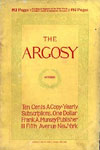Detective Story Magazine
With its premiere issue on October 5, 1915, Street & Smith's Detective Story Magazine became the first of many pulp magazines to devote itself entirely to the genre of crime fiction. Born out of the early nickel paper Nick Carter Weekly, Detective Story published from 1915 until the summer of 1949 a total of 1,057 issues, a longer run than any other detective pulp in history. Like many pulps, Detective Story is today greatly admired for its covers alongside its contents—thanks to prolific illustrator John A. Coughlin, who did every cover of the weekly magazine from 1915-1935, over 1,000 covers in all during this 20-year period.
Detective Story focused on short crime fiction—starring both detectives and Robin-Hood-type criminals, as well as costumed crime fighters, years before the hero pulps made such characters popular. The magazine also included detective-themed columns, such as "What Handwriting Reveals," "Expert Legal Advice," and "Under the Lamp," a weekly section on puzzles and ciphers. But Detective Story's popularity was primarily due to the serials it ran. Many of these featured well-known pulp characters such as Nick Carter, The Shadow, and Thubway Tham.
Writers published in the magazine over the course of its 20-year run included widely known mystery authors such as Agatha Christie, Dorothy Sayers, Raymond Chandler, and Edgar Wallace, along with admired pulp serialists Hugh Kahler and Johnston McCulley. Detective Story quickly branched out into the increasingly popular world of radio fiction with 'Detective Story Hour,' a serial crime program narrated by a mysterious figure known only as 'The Shadow.' When it debuted on July 31 1930, the program sent many confused listeners to stores requesting The Shadow Magazine—which did not yet exist, but which Street & Smith quickly produced in 1931.
Philosopher Ludwig Wittgenstein was one of Detective Story's most famous readers. An avid crime fiction enthusiast until his death in 1951, Wittgenstein quoted Detective Story in the last lecture he gave as a Trinity College fellow, and wrote in a 1945 letter, "If the U.S.A. won't give us detective mags we can't give them philosophy."
In 1932, Detective Story Magazine instituted a series of changes indicating the magazine was in trouble: the cover price fluctuated, publishing schedule varied, cover was redesigned, serials were dropped, issue page length went up and down, size moved from digest to pulp (and back again), and by 1935 all the columns had removed. As pulp magazines were unable to compete with the affordable and increasingly popular paperbacks after World War II, Street & Smith stopped publishing Detective Story in 1949, ending the longest surviving detective pulp.
Travis Kurowski, York College of Pennsylvania
Works Consulted and Further Reading
Cox, Randolph. The Dime Novel Companion. Westport, CT: Greenwood Publishers, 2000. 79-80.
Hoffman, Joseph. "Hard-boiled Wit: Ludwig Wittgenstein and Norbert Davis." Last accessed at http://www.mysteryfile.com/NDavis/Wit.html (2 Dec. 2011).
Jones, Gerard. Geeks, Gangsters, and the Birth of the Comic Book. New York, NY: Basic Books, 2004.
Martin, Walker. "Collecting Pulps: A Memoir Part Four—Detective Story Magazine." Last accessed at http://mysteryfile.com/blog/?p=5566 (2 Dec. 2011).
Sampson, Robert. Yesterday's Faces: Volume 4: The Solvers. Bowling Green, OH: Bowling Green State University Popular Press, 1987.





